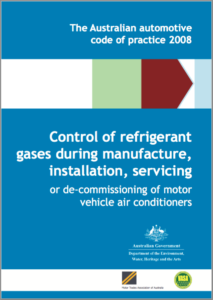Automotive Code of Practice update
- PostedPublished 20 December 2015
The working group considering a review of the 2008 Australian Automotive Air Conditioning Code of Practice has been discussing how the CoP is used and by whom, plus the issues for consideration during a review.
Why and who uses the Code of Practice?
| Uses for the Code of Practice | Who uses the Code of Practice |
| Standards/enforcement | Government |
| Education/training | Trainer/student |
| Reference guide | Technicians |
| Audits | ARC Field Officers |
| Evidence of workmanship/consumer protection | Business and clients |
| Safe/known work environment | Technician |
Issues for consideration during review
| Education/training | Record keeping |
| Safety/retrofitting | Penalties – link to regulations |
| Information on refrigerants | Reference and relevance to relevant departments |
| Return streams – mixtures | Risk assessments |
| Equipment testing | Electric vehicles |
| Labelling | Personal protective equipment guidance |
| Original equipment manufacturer guidelines | Level of equipment |
| Work practice standards |
The working group was formed following the Mobile Air Conditioning and Transport Refrigeration & Air Conditioning Summit in Sydney on August 27 2014.
VASA was heavily involved the development of the existing CoP and the VASA logo is on the front cover. Due to significant industry and technological changes since 2008 and the upcoming Ozone Acts review, VASA strongly believes the document needs to be updated and is playing an active role in working towards a review.
Refrigerant Code of Practice: downloada your free copy today

The Australian Automotive code of practice is a practical guide on how to comply with legal duties under the current ozone legislation, when it comes to the handling of fluorocarbon refrigerant gases.
As part of ARCTick licence obligations, work practices should follow the codes of practice. This means you are actively working to reduce emissions of harmful refrigerant into the atmosphere, as well as practicing safe, efficient and professional work processes.
The codes of practice are also a handy reference tool for you when you are working on air conditioning jobs.
Australian Refrigeration Council (ARC) Field Officers check to see that the code of practice is being followed by licence holders during an audit, so it is important that all ARCTick authorisation and licence holders are familiar with the requirements. Highlighted below are some of the questions that might be asked during audit:
- What action do you take when an air conditioner is not operating correctly and the system is found to be out of refrigerant?
- How do you know what type of refrigerant is being recovered during a recovery exercise?
Which label do you attach to a system after the completion of a service? - What action would you take if you had doubts about the integrity of an air conditioning system?
- Have you marked recovery/pump down cylinders in accordance with the code of practice?
Visit the ARC website to read more about the audit process: www.arctick.org/business-authorisation/auditing
Download a free copy from the ARC website
If you do not have a copy of the Australian automotive code of practice at your work, you can download the current edition from the ARC website at: www.arctick.org/licensing/codes-of-practice/
- CategoriesIn SightGlass
- TagsSightGlass News Issue 4


